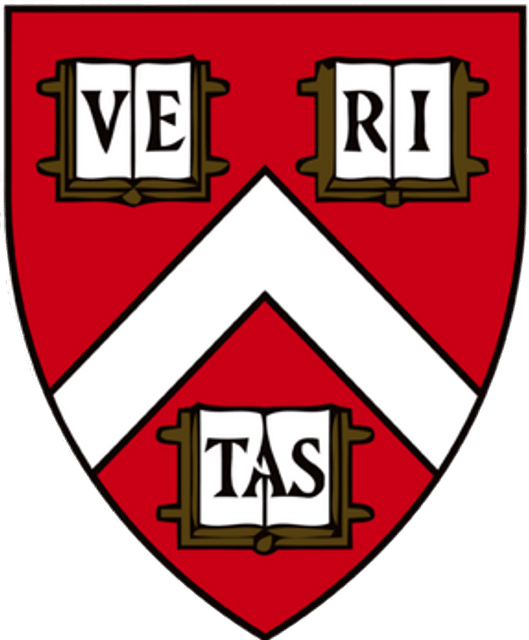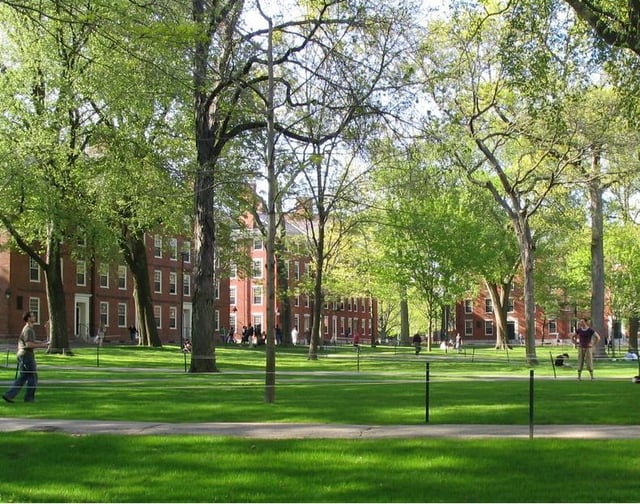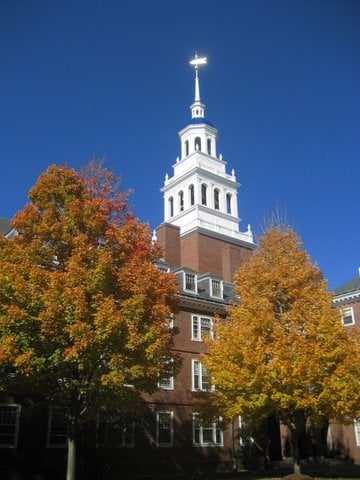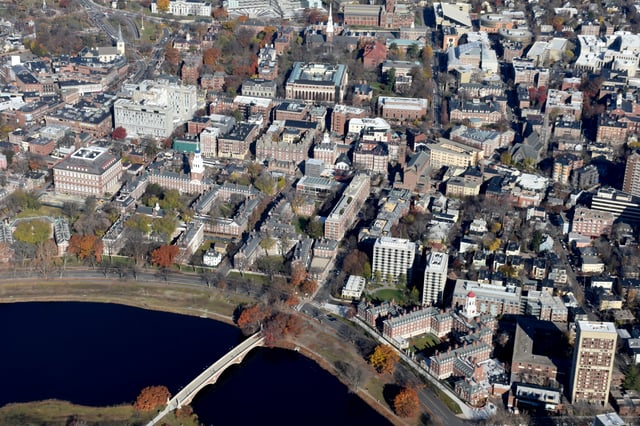Harvard College

Harvard College

| Type | Private school |
|---|---|
| Established | 1636 |
| Students | 6,700[2] |
| Location | Cambridge, Massachusetts |
| Campus | Urban |
| Website | college.harvard.edu [37] |
Harvard College is the undergraduate liberal arts college of Harvard University. Founded in 1636 in Cambridge, Massachusetts, it is the oldest institution of higher learning in the United States[3] and one of the most prestigious in the world.[4]
| Type | Private school |
|---|---|
| Established | 1636 |
| Students | 6,700[2] |
| Location | Cambridge, Massachusetts |
| Campus | Urban |
| Website | college.harvard.edu [37] |
History

Colonial buildings belonging to Harvard College

Freshman dormitories in Harvard Yard
The school came into existence in 1636 by vote of the Great and General Court (colonial legislature, second oldest in British America) of the Massachusetts Bay Colony—though without a single building, instructor, or student. In 1638, the college became home for North America's first known printing press, carried by the ship John of London.[5][6] Three years later, the college was renamed in honor of deceased Charlestown minister John Harvard (1607–1638) who had bequeathed to the school his entire library and half of his monetary estate.
Harvard's first instructor was schoolmaster Nathaniel Eaton (1610–1674); in 1639, he also became its first instructor to be dismissed, for overstrict discipline.[7] The school's first students were graduated in 1642. In 1665, Caleb Cheeshahteaumuck (c. 1643–1666) "from the Wampanoag … did graduate from Harvard, the first Indian to do so in the colonial period."[8]
The colleges of England's Oxford and Cambridge Universities are communities within the larger university, each an association of scholars sharing room and board. Harvard's founders may have envisioned it as the first in a series of sibling colleges on the English model which would eventually constitute a university—though no further colleges materialized in colonial times. The Indian College was active from 1640 to no later than 1693, but it was a minor addition not operated in federation with Harvard according to the English model. Harvard began granting higher degrees in the late eighteenth century, and it was increasingly styled Harvard University, even as Harvard College was increasingly thought of as the university's undergraduate division in particular.
Today Harvard College is responsible for undergraduate admissions, advising, housing, student life, and athletics – generally all undergraduate matters except instruction, which is the purview of Harvard University's Faculty of Arts and Sciences. The body known as The President and Fellows of Harvard College retains its traditional name despite having governance of the entire University. Radcliffe College (established 1879)[9] originally paid Harvard faculty to repeat their lectures for women students. Since the 1970s, Harvard has been responsible for undergraduate governance matters for women; women were still formally admitted to and graduated from Radcliffe until a final merger in 1999.[10]
Academics
Midway through the second year, most undergraduates join one of fifty standard fields of concentration (what most schools call academic majors); many also declare a secondary field (called minors elsewhere). Joint concentrations (combining the requirements of two standard concentrations) and special concentrations (of the student's own design) are also possible.
Most Harvard College concentrations lead to the Artium Baccalaureus (A.B.), normally completed in four years. A smaller number receive the Scientiarum Baccalaureus (S.B.). There are also special degree programs, such as a five-year program leading to both a Harvard undergraduate degree and a Master of Arts from the New England Conservatory of Music.
Undergraduates must also fulfill the general education requirement of coursework in a few designated fields. Each student's exposure to a range of intellectual areas, while pursuing a chosen concentration in depth, fulfills the injunction of Harvard past-president Abbott Lawrence Lowell that liberal education should produce "men who know a little of everything and something well."[15]
The total annual cost of attendance, including tuition and room and board, for 2018–2019 was $67,580.[19] Under financial aid guidelines adopted in 2012, families with incomes below $65,000 no longer pay anything for their children to attend. Families with incomes between $65,000 to $150,000 pay no more than 10 percent of their annual income.[20]
House system

Lowell House

River Houses
Nearly all undergraduates live on campus, for the first year in dormitories in or near Harvard Yard and later in the upperclass houses—administrative subdivisions of the college as well as living quarters, providing a sense of community in what might otherwise be a socially incohesive and administratively daunting university environment. Each house is presided over by a senior-faculty dean, while its Allston Burr Resident Dean—usually a junior faculty member—supervises undergraduates' day-to-day academic and disciplinary well-being.
The faculty dean and resident dean are assisted by other members of the Senior Common Room—select graduate students (tutors), faculty, and university officials brought into voluntary association with each house. Many tutors reside in the house, as do the faculty dean and resident dean. Terms like tutor, Senior Common Room, and Junior Common Room reflect a debt to the residential college systems at Oxford and Cambridge from which Harvard's system took inspiration.[21]
The houses were created by President Lowell in the 1930s to combat what he saw as pernicious social stratification engendered by the private, off-campus living arrangements of many undergraduates at that time. Lowell's solution was to provide every man—Harvard was male-only at the time—with on-campus accommodations throughout his time at the college; Lowell also saw great benefits flowing from other features of the house system, such as the relaxed discussions—academic or otherwise—which he hoped would take place among undergraduates and members of the senior common room over meals in each house's dining hall.[22]
The way in which students come to live in particular houses has changed greatly over time. Under the original "draft" system, masters negotiated privately over the assignment of "rising sophomores" (next academic year's sophomores), considered most or least promising. From the 1960s to the mid-1990s, each student ranked the houses according to personal preference, with an impersonal lottery resolving the oversubscription of more popular houses. Today, groups of one to eight freshmen form a block which is then assigned, essentially at random, to an upperclass house. Housing Day is held annually in March, where upperclassmen visit the freshman dorms and welcome new house members into their residence. In recent years, houses have commemorated Housing Day by developing House T-shirts, sponsoring welcome parties and developing Housing Day videos, spotlighting the positive features of their residence.
A total of nine "River Houses" are located south of Harvard Yard, near the Charles River: Adams, Dunster, Eliot, Kirkland, Leverett, Lowell, Mather, Quincy, and John Winthrop House. Their construction was financed largely by a 1928 gift from Yale alumnus Edward Harkness, who, frustrated in his attempts to initiate a similar project at his alma mater, eventually offered $11 million to Harvard.[1][26] Two of the new houses, Dunster and Lowell, were completed in 1930.[23]
Construction of the first houses began in 1929,[23] but the land on which they were built had been assembled decades before. After graduating from Harvard in 1895, Edward W. Forbes found himself inspired by the Oxford and Cambridge systems during two years of study in England; on returning to the United States he set out to acquire such land between Harvard Yard and the Charles River as was not already owned by Harvard or some associated entity. By 1918 that ambition had been largely fulfilled and the assembled land transferred to Harvard.[27][28]
The three "Quad Houses" enjoy a residential setting half a mile (800 m) northwest of Harvard Yard. These were built by Radcliffe College and housed Radcliffe College students until the Harvard and Radcliffe residential systems merged in 1977.[29] They are Cabot, Currier, and Pforzheimer House. A thirteenth house, Dudley House, is nonresidential but fulfills, for some graduate students and the (very few) undergraduates living off campus, the administrative and social functions provided to on-campus residents by the other twelve houses. Harvard's residential houses are paired with Yale's residential colleges in sister relationships.
Athletics
By the late 19th century, critics of intercollegiate athletics, including Harvard president Charles William Eliot, believed that sports competition had become over-commercialized and took students away from their studies, and they called for reform and limitations on all sports.
This opposition prompted Harvard's athletic committee to target 'minor' sports—basketball and hockey—for reform and regulation in order to deflect attention from the major sports—football, baseball, track, and crew. The committee made it difficult for the basketball team to operate by denying financial assistance and limiting the number of overnight away games in which the team could participate.
Several losing seasons, negative attitudes toward the commercialization of intercollegiate sports, and the need for reform contributed to basketball's demise at Harvard in 1909.[30]
Originating in 1852, the Harvard–Yale Regatta is the oldest intercollegiate athletic rivalry in the United States. Also well-known is the annual Harvard–Yale football game.
Student organizations
Harvard has hundreds of undergraduate organizations.[31] The Phillips Brooks House Association acts as an umbrella service organization.
In an effort to marginalize organizations that "contribute to a social life and a student culture that for many on our campus is disempowering and exclusionary",[32] students entering in the fall of 2017 or later who join unrecognized single-sex organizations (such as single-sex "final clubs", fraternities, and sororities) will be barred from campus leadership positions such as team captaincies, and from receiving recommendation letters from Harvard requisite for certain scholarships and fellowships.[33]
Notable alumni
- ArchitectureBuckminster Fuller(expelled)Philip JohnsonArtsEllen HarveyAlex KahnWaldo PeirceMarina RosenfeldAstronauticsStephanie WilsonAstronomyAndrew FraknoiAthleticsCraig AdamsMatt BirkEmily CrossRyan FitzpatrickBobby JonesJeremy LinEsther LofgrenDominic MooreChristopher NowinskiRyan Max RileyPaul WylieBiologyHarold M. WeintraubBusinessSteve BallmerLloyd BlankfeinJim CramerBill Gates(did not graduate)James Halperin(did not graduate)Trip HawkinsWilliam Randolph Hearst(rusticated)Sumner RedstoneMark Zuckerberg(did not graduate)EconomicsBen BernankeMartin FeldsteinJason FurmanSteven LevittMerton MillerEduardo SaverinRobert M. SolowJames TobinEducationPrince Lucien CampbellJohn PhillipsEdwin H. Baker PrattJournalismHarry CrossNelson DenisHendrik HertzbergNicholas D. KristofAnthony LewisWalter LippmannLeon NeyfakhSylvia PoggioliDavid E. SangerSanford J. UngarLawHarry BlackmunOliver Wendell Holmes, Jr.John RobertsDavid SouterLiteratureJames AgeeWilliam S. BurroughsMichael CrichtonE. E. CummingsJohn Dos PassosW. E. B. Du BoisT. S. EliotJean KwokNorman MailerEdmund PearsonMax PerkinsErich SegalWallace StevensJohn UpdikeMathematicsManjul BhargavaBuddy FletcherTheodore KaczynskiTom LehrerPerforming artsCharlie AlbrightDarren AronofskyParis BarclayLeonard BernsteinAndy BorowitzAmy BrennemanCarter BurwellNestor CarbonellRivers CuomoMatt Damon(did not graduate)Nelson DenisFred GwynneHao HuangRashida JonesTommy Lee JonesColin JostJack LemmonRyan LeslieJohn LithgowDonal LogueYo-Yo MaTerrence MalickLorenzo MarianiTom MorelloDean NorrisConan O'BrienNatalie PortmanJoshua RedmanMeredith SalengerElisabeth ShueMichael SternWhit StillmanMira SorvinoJames TobackPhilosophyDonald DavidsonDaniel DennettRalph Waldo EmersonCharles Sanders PeirceW.V.O. QuineGeorge SantayanaHenry David ThoreauPhysicsPhilip Warren AndersonTheodore HallThomas S. KuhnJ. Robert OppenheimerNeil deGrasse TysonPoliticsJohn AdamsJohn Quincy AdamsSamuel AdamsCharlie BakerBenazir BhuttoPedro Albizu CamposSir George DowningAl FrankenRahul GandhiElbridge GerryAl GoreJohn HancockEdward M. KennedyJohn F. KennedyRobert F. KennedyHenry KissingerMatthew MayhewMasako OwadaDeval PatrickTom RidgeJay RockefellerFranklin Delano RooseveltTheodore RooseveltChuck SchumerMeshech WeareJohn WestonReligionJoseph Stevens BuckminsterAga Khan IVCotton MatherIncrease MatherJonathan MayhewTheodore ParkerSamuel Parris